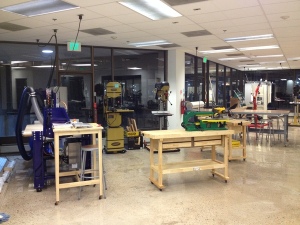Thursday evening at Denver Biolabs
Denver Biolabs is a DIY bio group that got started by RJ Duran and Heather Underwood. Apparently there was a Boulder Biohacker group that got organized, had one meeting and then never another. Before all the enthusiasm and ambition for Front Range DIY bio dissipated, RJ collected the Boulder mailing list and he and Heather started Denver Biolabs at inWorks on the CU Denver campus.
CU Denver has an exciting new space called inWorks that is committed to purposeful and intentional problem solving. Heather Underwood is the Associate Director of inWorks, and is excited to see the space grow. The facility is brand new, and has so much potential for where it can go and what can happen, and Heather is leading the charge to develop a strong biological component at inWorks. It’s a beautiful space with 3d printers, machine tools, and lots of equipment I can’t even identify that is good for building, prototyping, doing electronics, and who knows what else. Right now the community can participate in workshops and short courses, and as they grow they will be figuring out a good system for utilizing the space and equipment for everyone who wants to and has been properly trained to use it.
I gave a talk on Thursday (29 Jan 2015) at inWorks to the Denver Biolabs group about the work we are doing at Revolution Bio making beautiful consumer biotechnology products: color-changing flowers. The audience had a mix of technical (not biology) backgrounds, as well as Ph.Ds in plant molecular biology, so the talk was just an informal and fun discussion about plant pigments and generalized strategies to change flower color. The audience was engaged and there were lots of great questions about both the science of flower color, and questions about regulations and business.
I’m glad RJ and Heather got things rolling for the DIY bio scene in Colorado, and I’m happy to be a part of that group. However, after my parking ticket last night, I don’t think I’m going to try and park anywhere near inWorks, and just plan on a nice walk.
Get involved with Denver Biolabs on Meetup or on Facebook.
Find out more about inWorks at CU Denver at their website.







